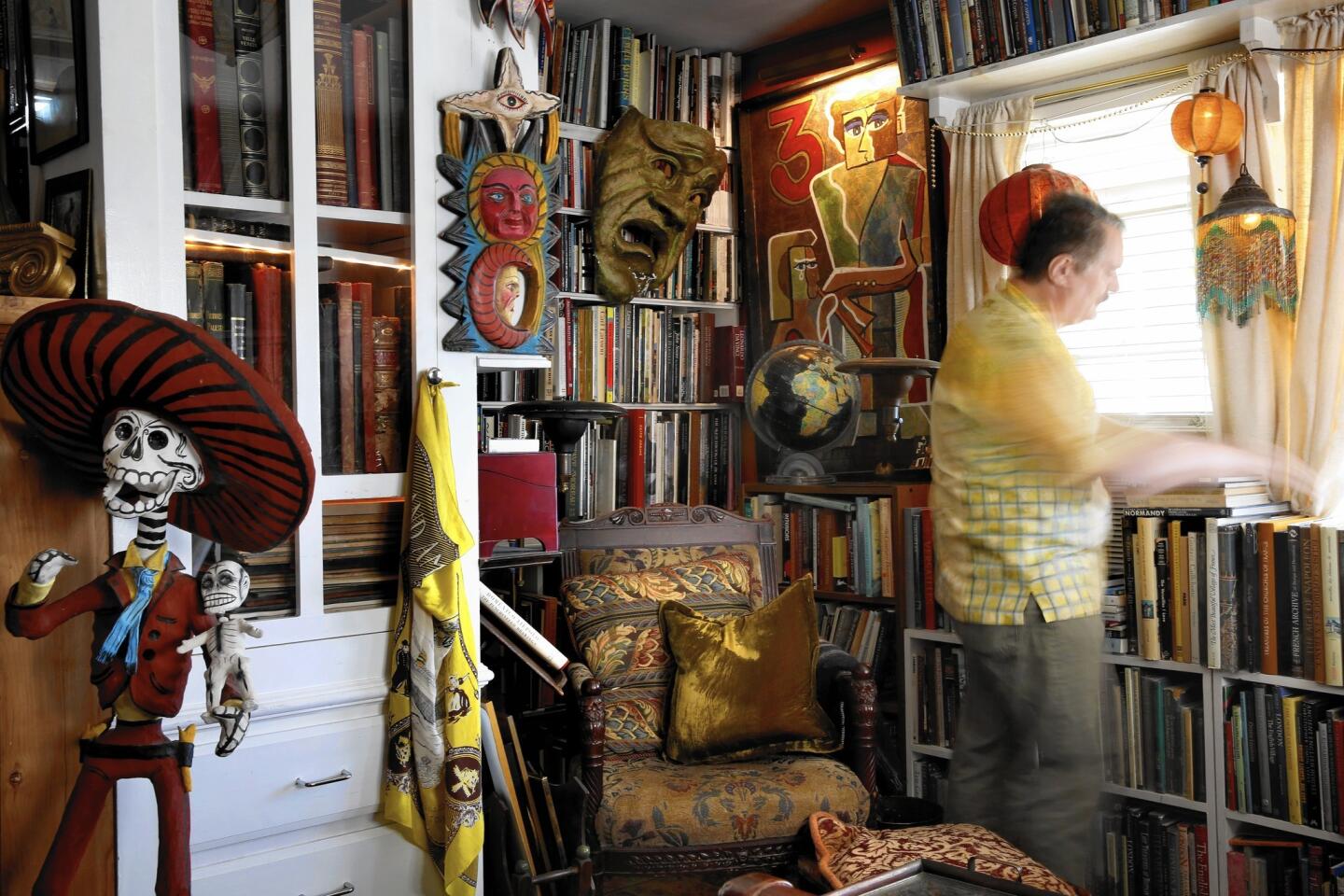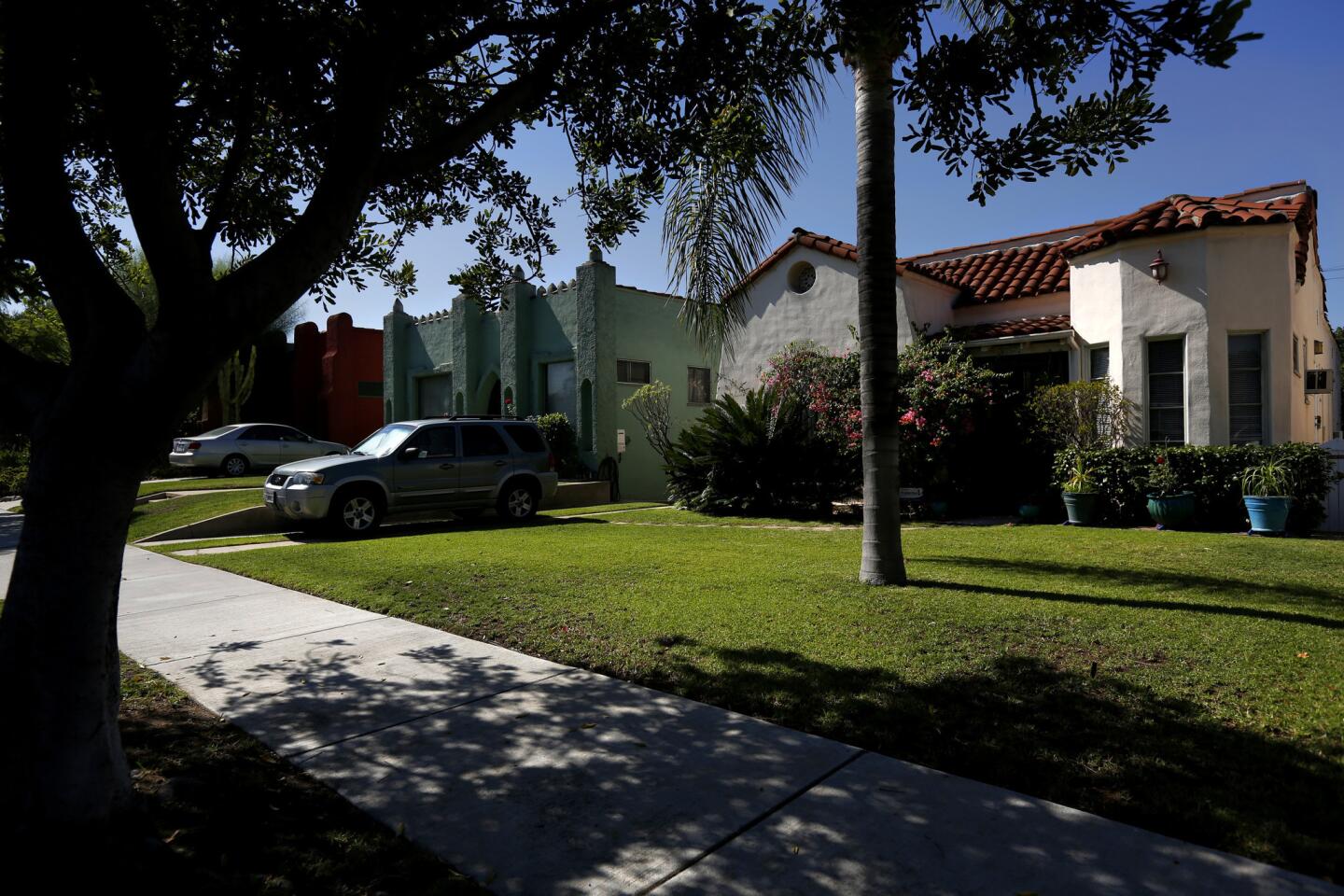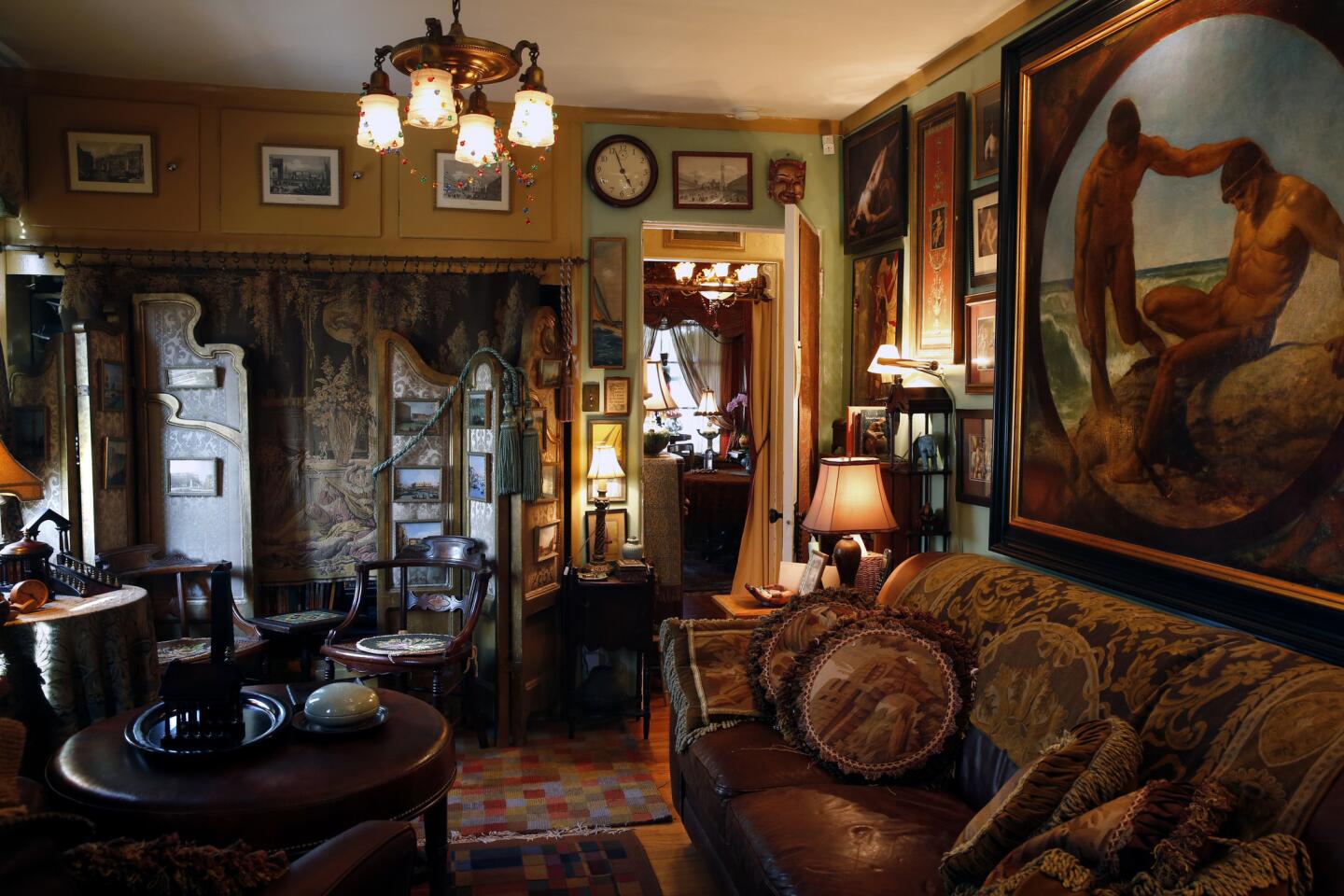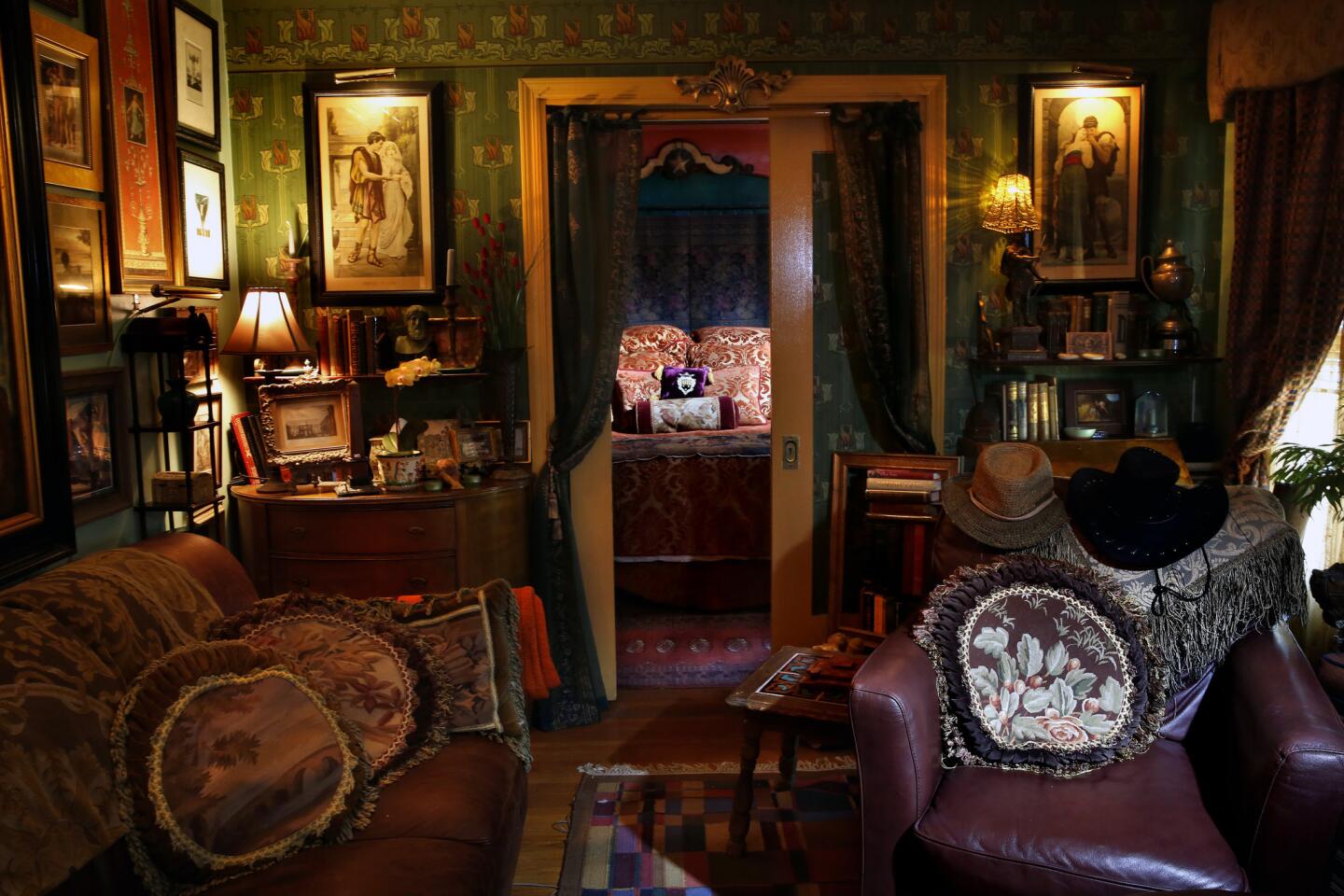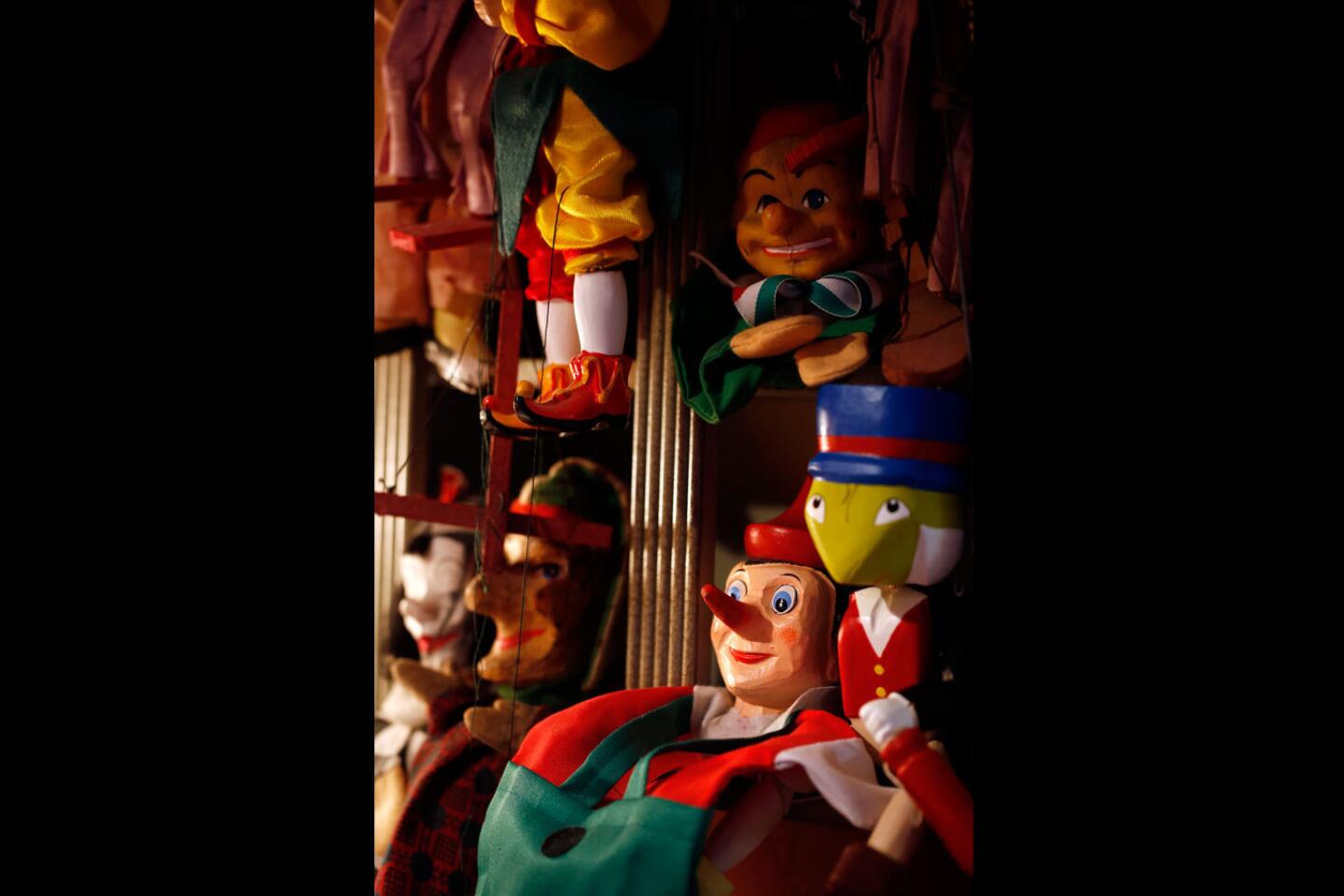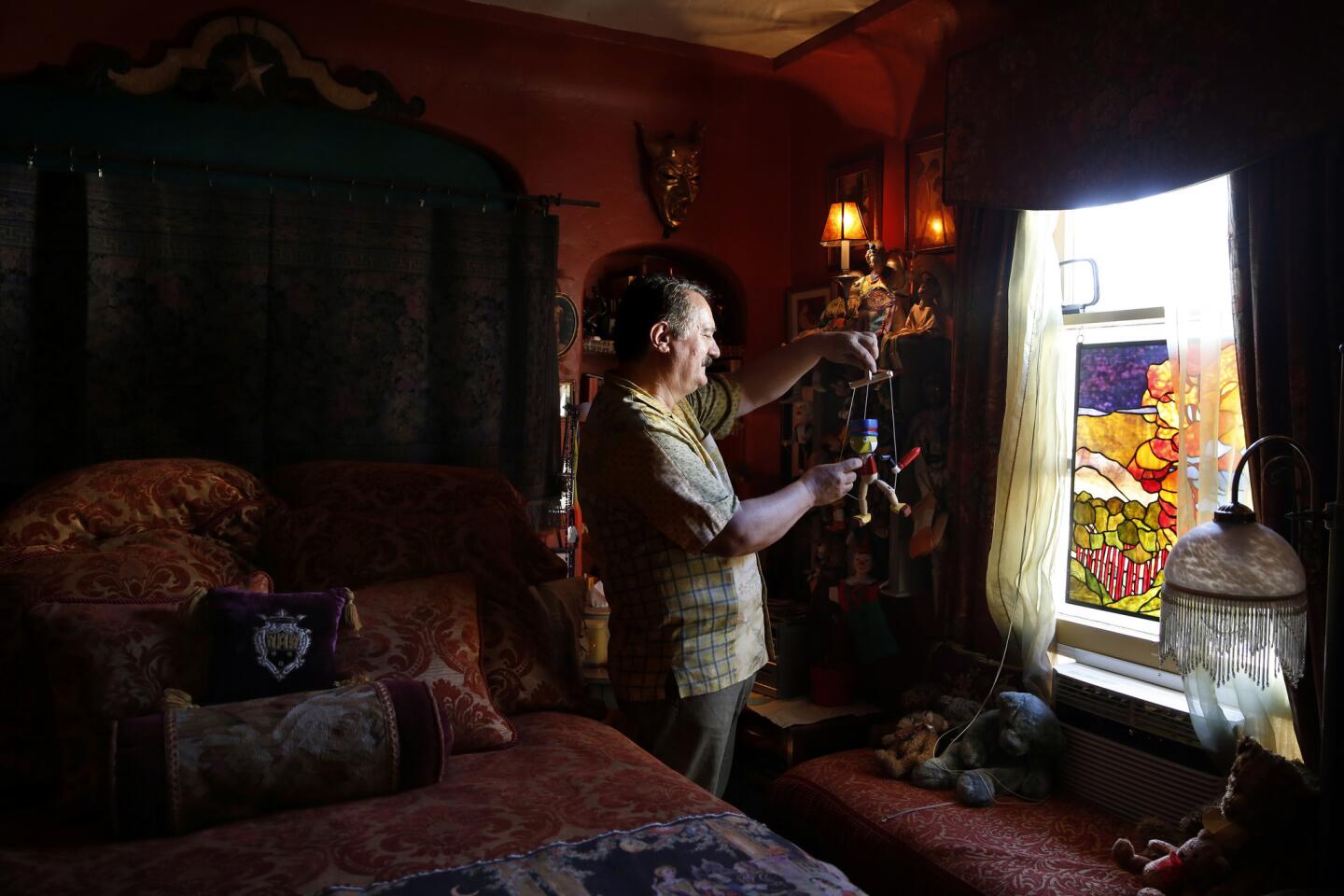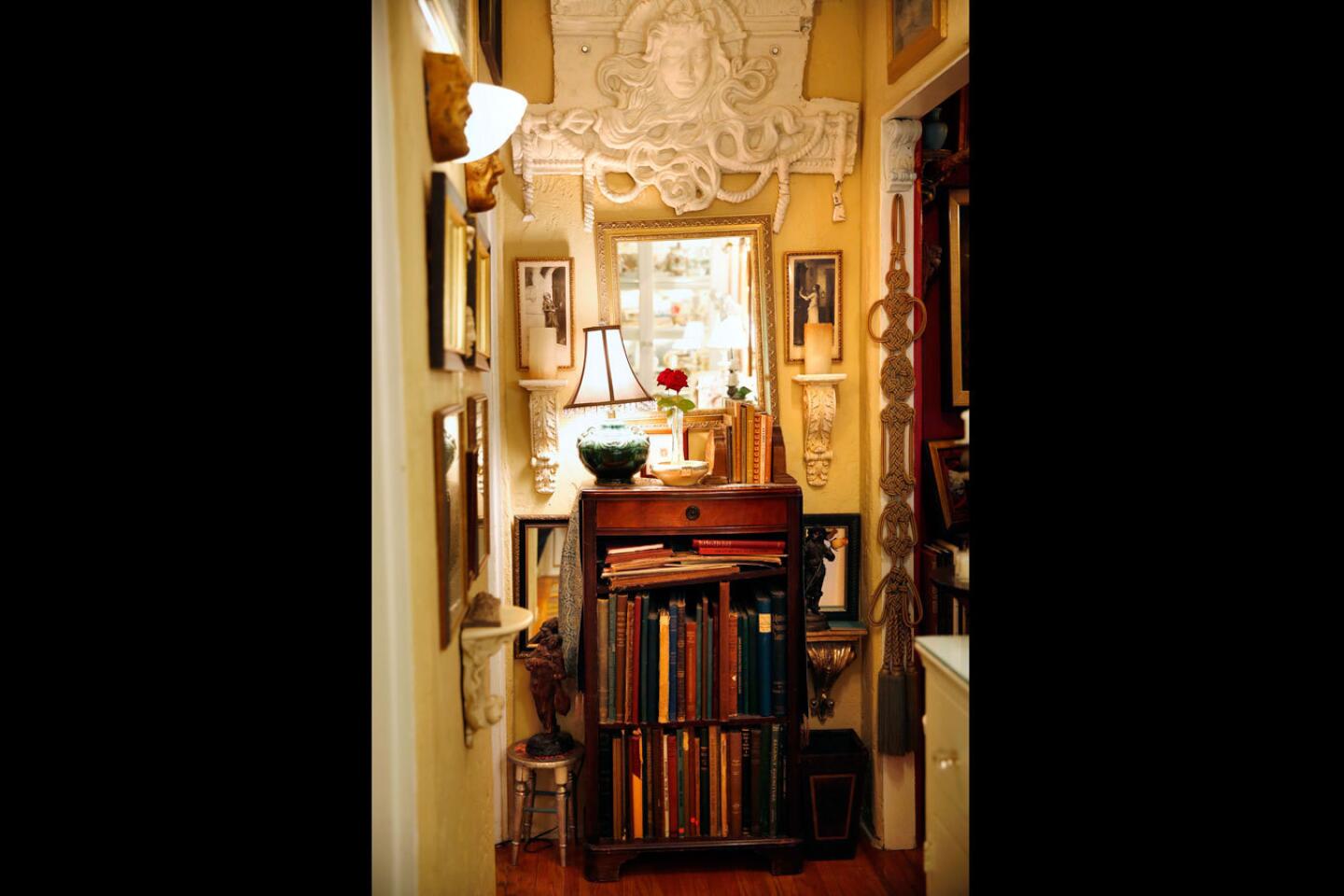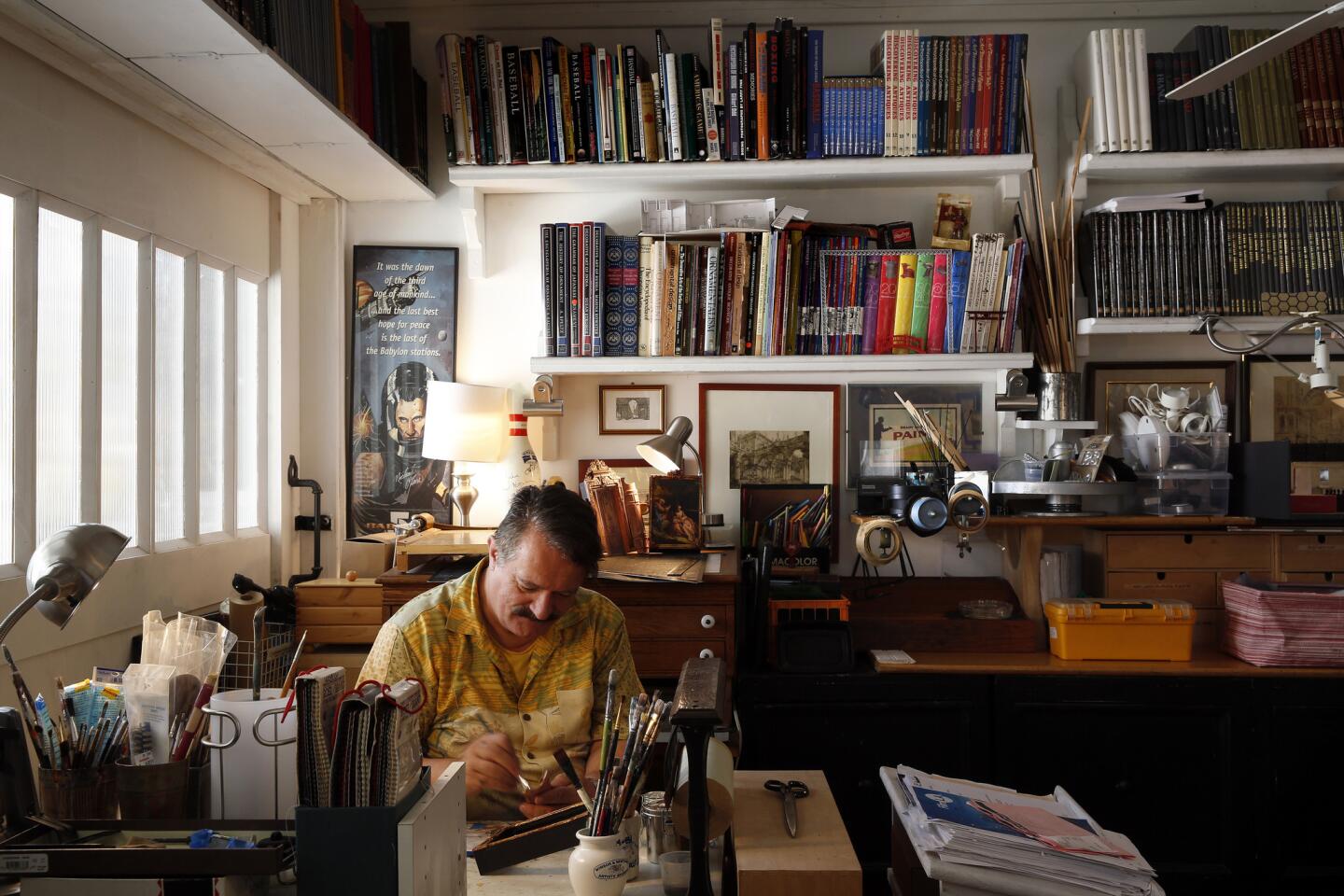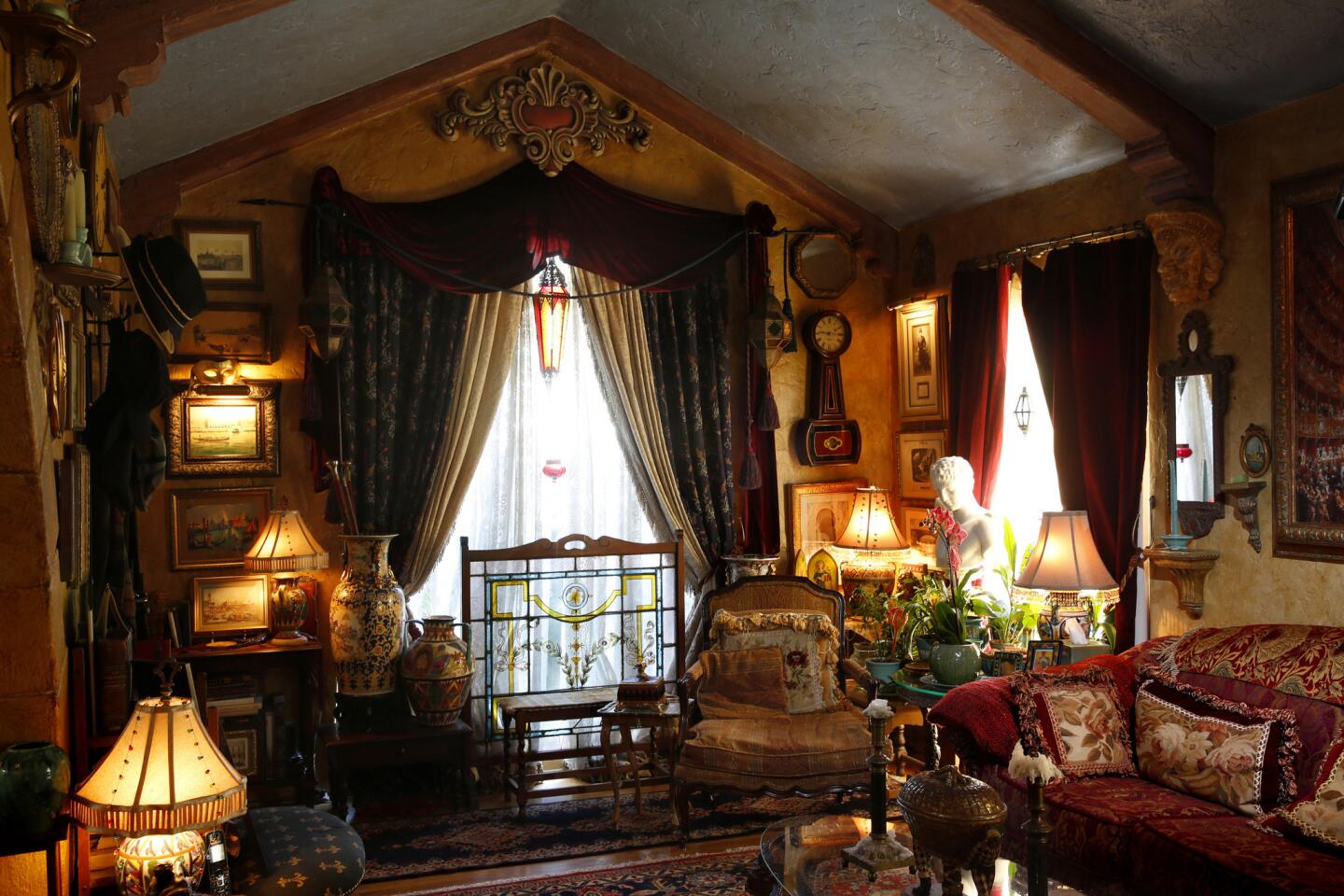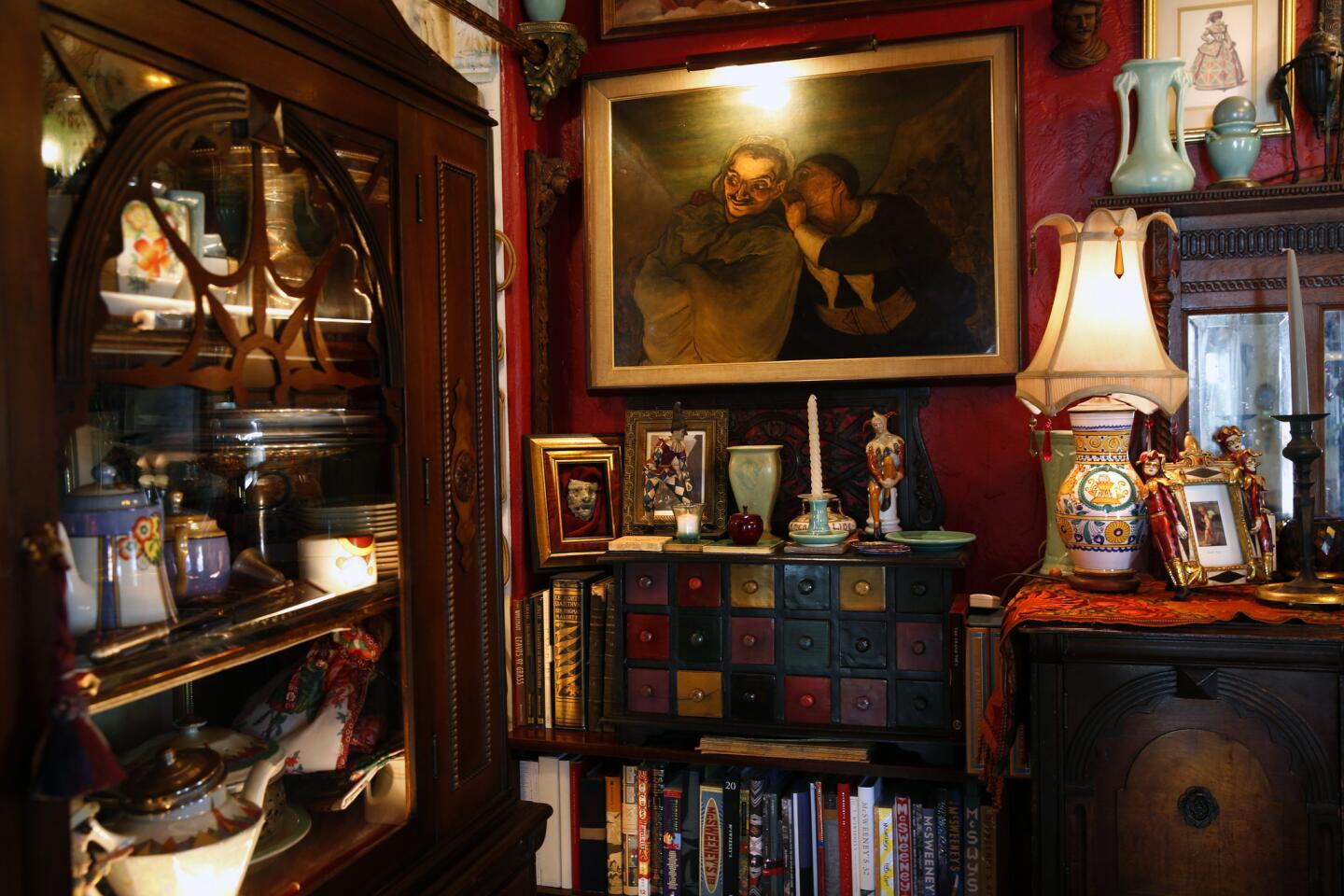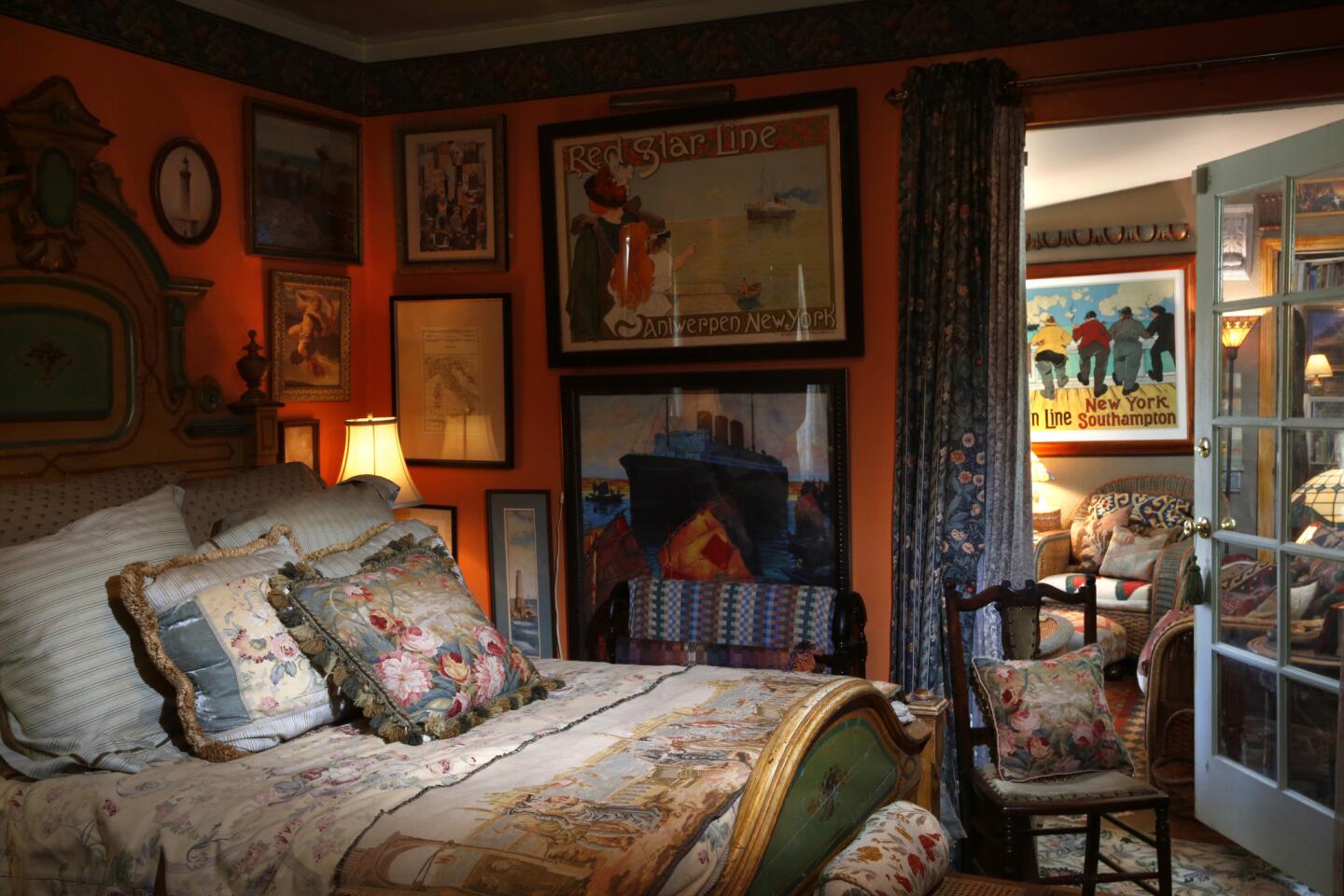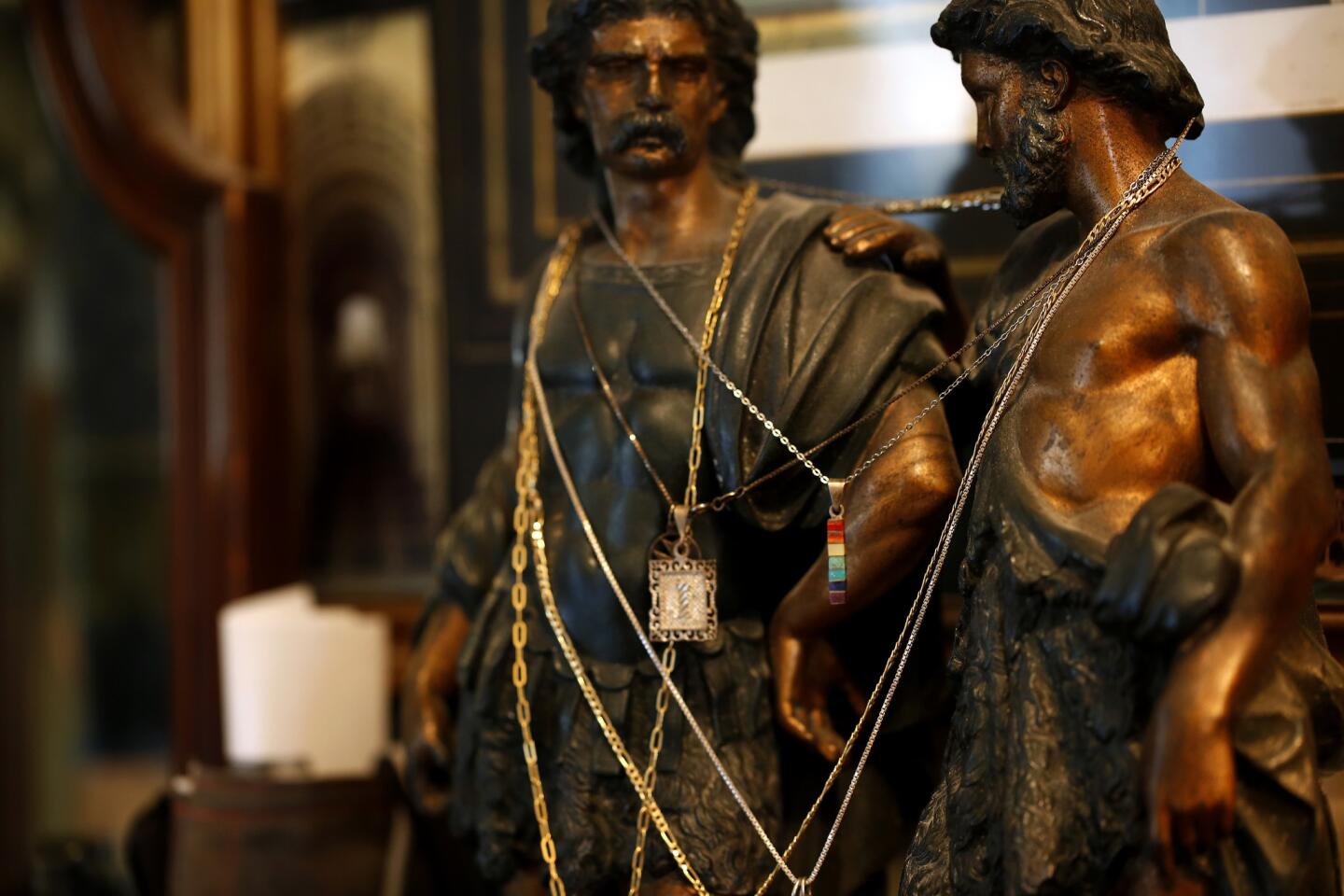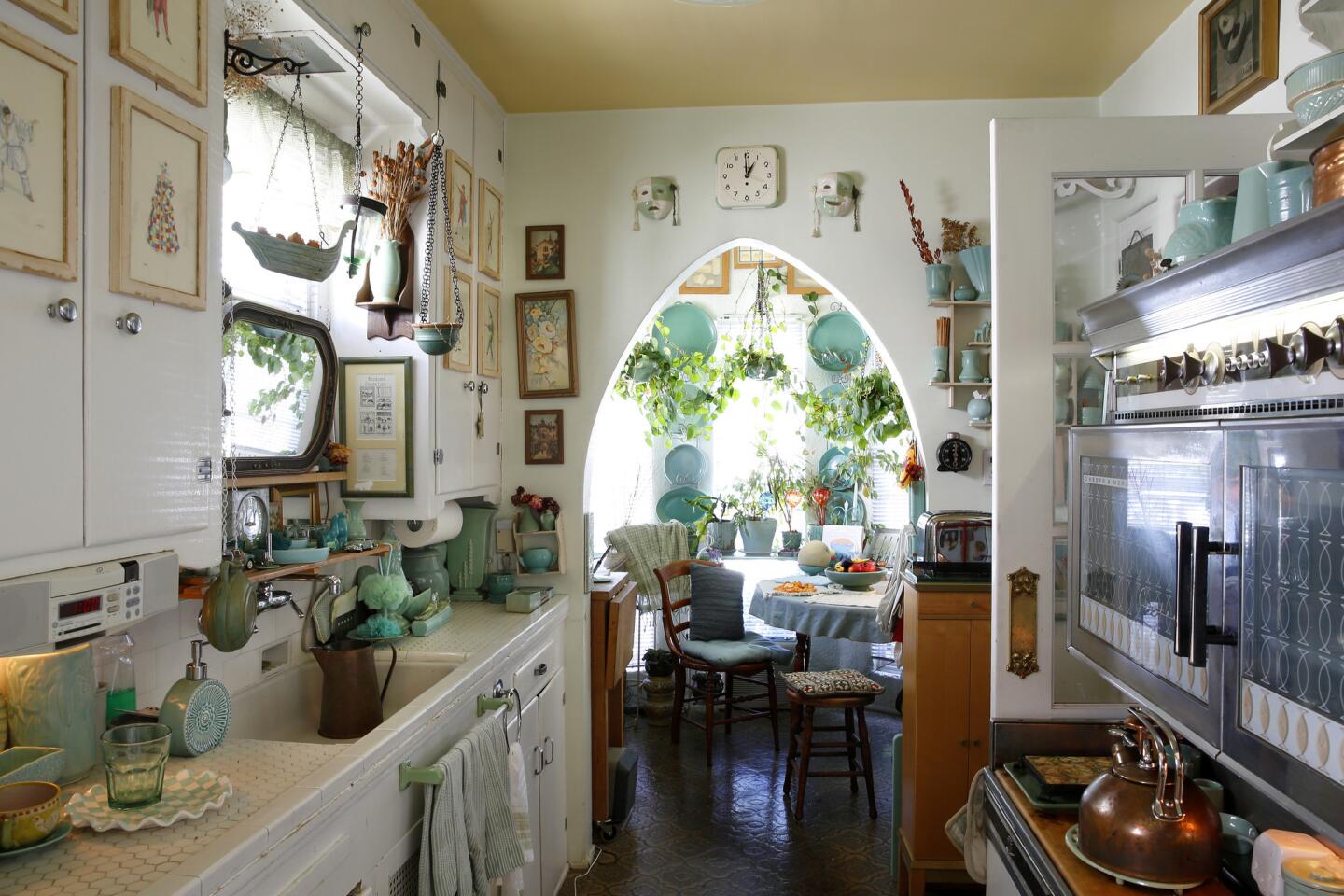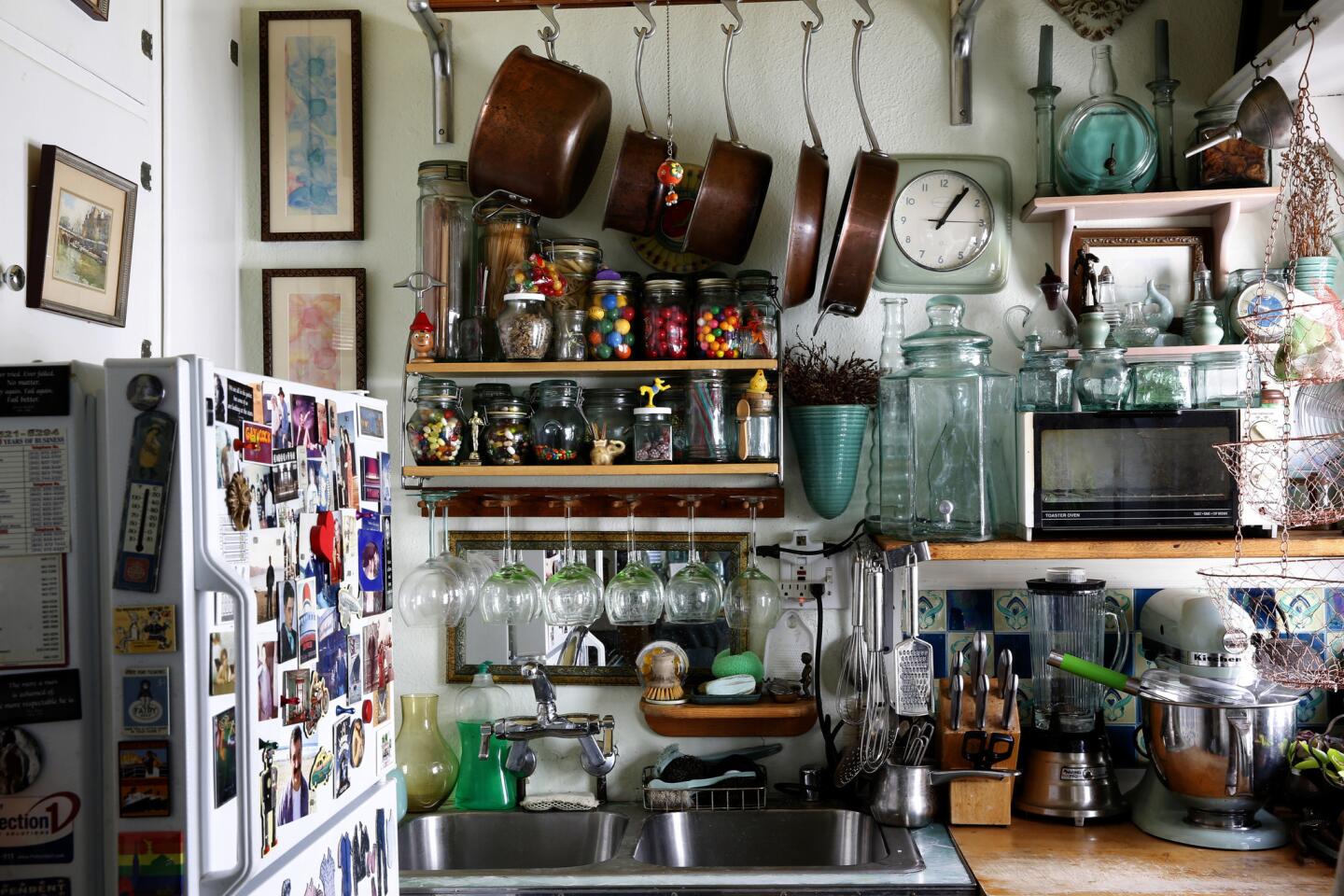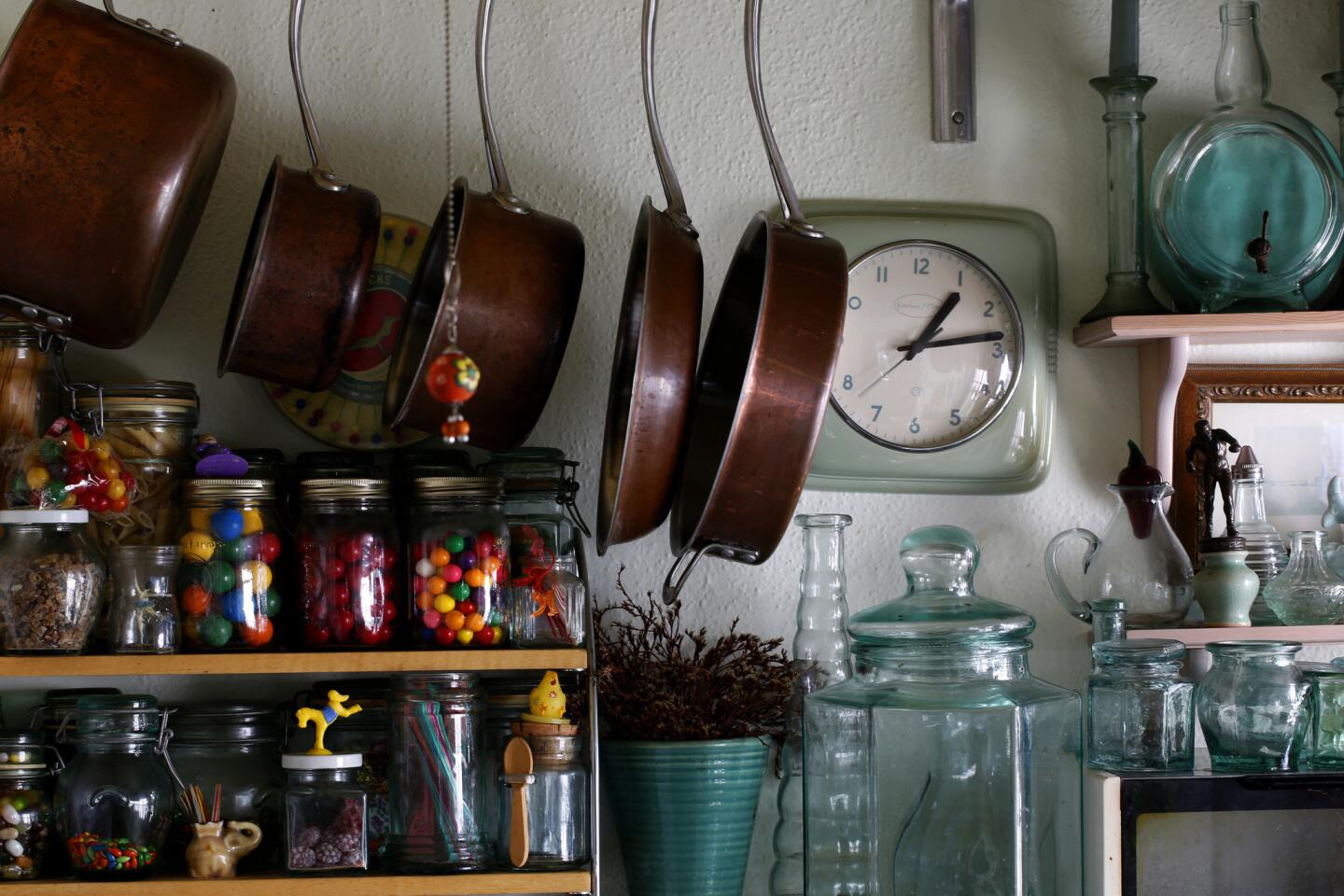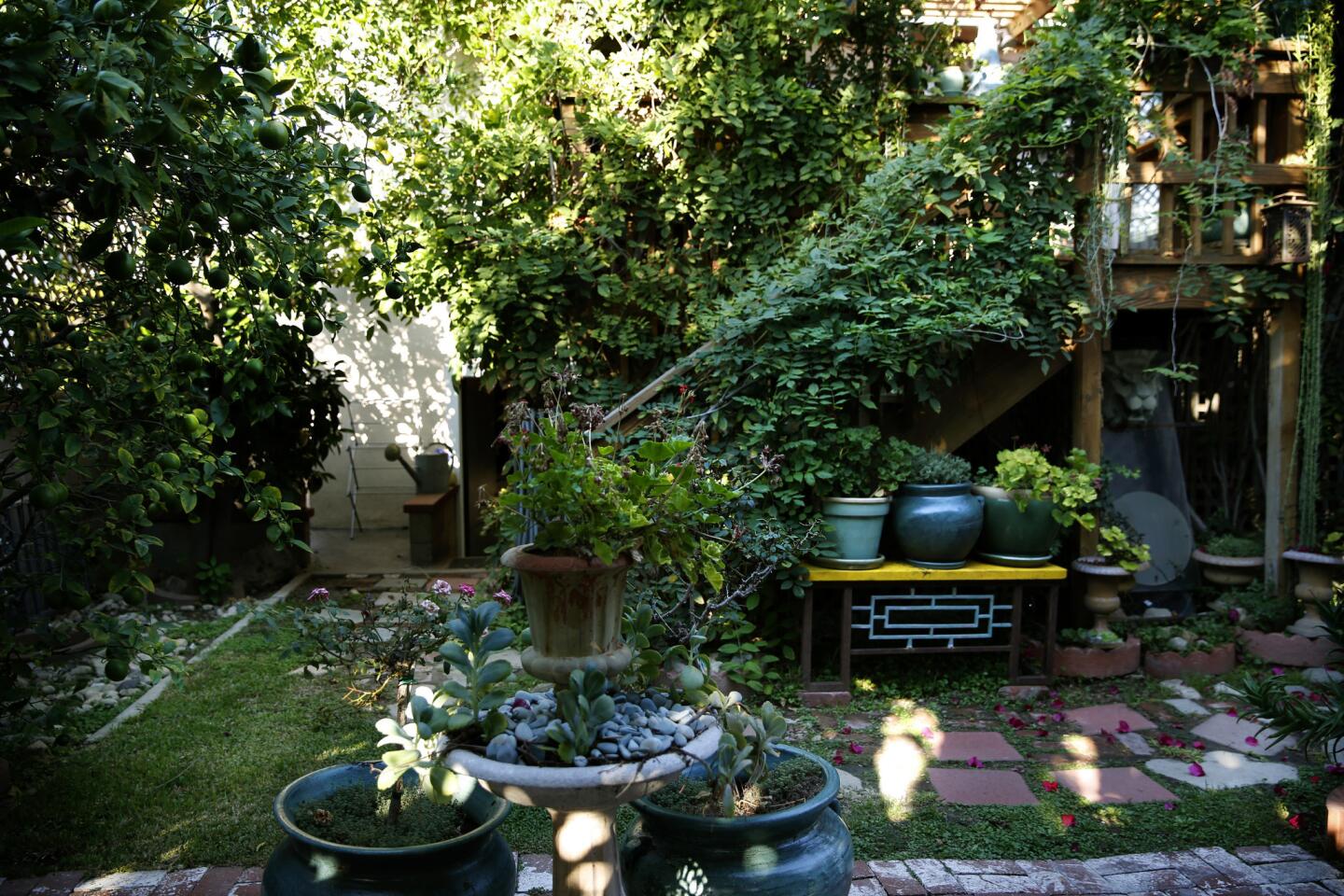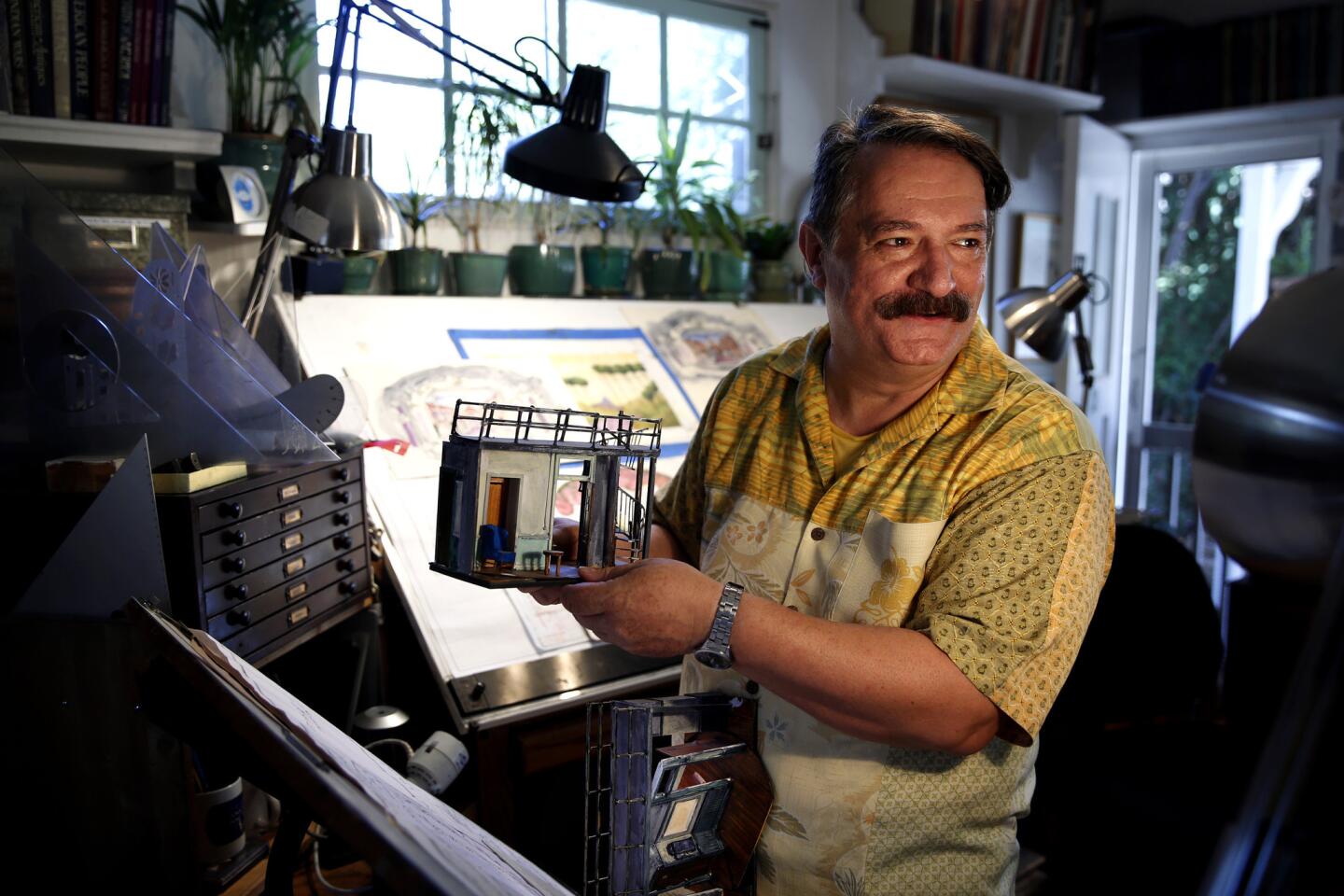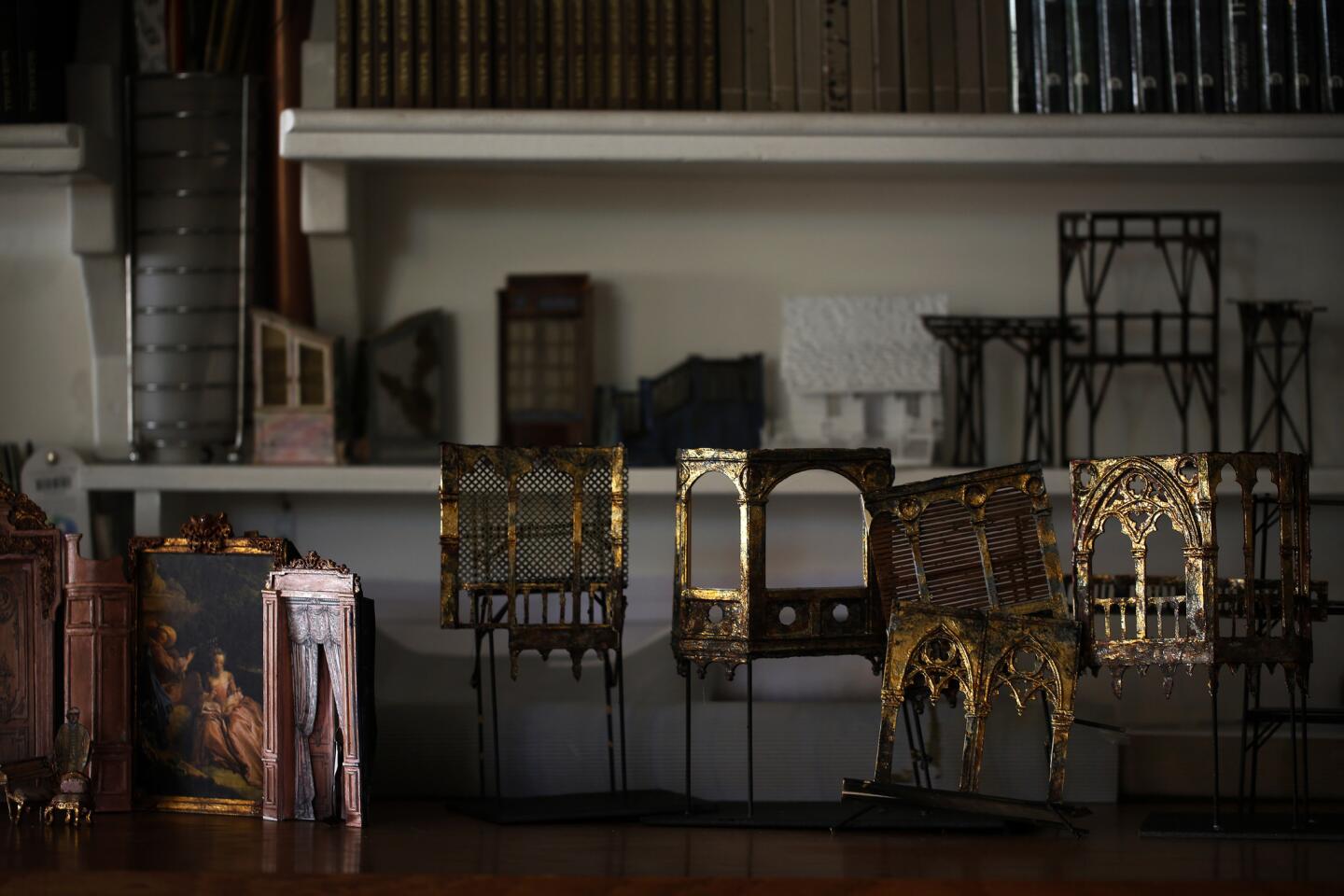On set, John Iacovelli is a production designer. At home, he’s a mad scientist of decor.
- Share via
Production designer and art director John Iacovelli has worked on sets for TV spectaculars (“Peter Pan”) and series (“Ed,” “Babylon 5”), feature films (“Honey, I Shrunk the Kids”) and scores of stage plays, but the Emmy winner’s most theatrical — and personal — interiors can be found in his 1927 Atwater Village home, which is filled with furnishings and memorabilia from his decades-long career. And it’s altogether fitting that he lives in a house built by Barney Kenoffel, a real estate developer who created a string of fantasy bungalows on Brunswick Avenue that were inspired by ancient architecture seen in silent movie sets.
“There has always been a rumor that out-of-work Hollywood art directors in the transition between silent films and the talkies designed the houses in this row,” says Iacovelli, whose two-bedroom, one-bath home is situated among fanciful examples of Assyrian, Egyptian and Babylonian dwellings. He purchased the property, which had a back house added in 1959, in 1999. Although the exterior suggests Spanish Colonial Revival, Iacovelli believes the more pointed Gothic arches throughout the interior put the house firmly in the Venetian Revival style.
The Italian American, who grew up in Reno, has incorporated multiple references to Venice in decorating his home, including gilt and painted furniture, landscapes of that city and a massive theatrical painted backdrop depicting the Rialto Bridge. An avid scholar of the decorative arts, Iacovelli also collects French Art Deco, Belgian tapestries, Mexican marionettes, Catalina tile tables and 20th century matte green American pottery. And, having previously lived in rentals, he felt free to indulge his taste for a palette he calls “spicy bright” — warm oranges, reds and yellows and blues that are on the green side. Iacovelli’s bold wall and ceiling colors — oxblood red and cobalt blue in the dining room — are enhanced with glazing techniques he learned as a scenery painter.
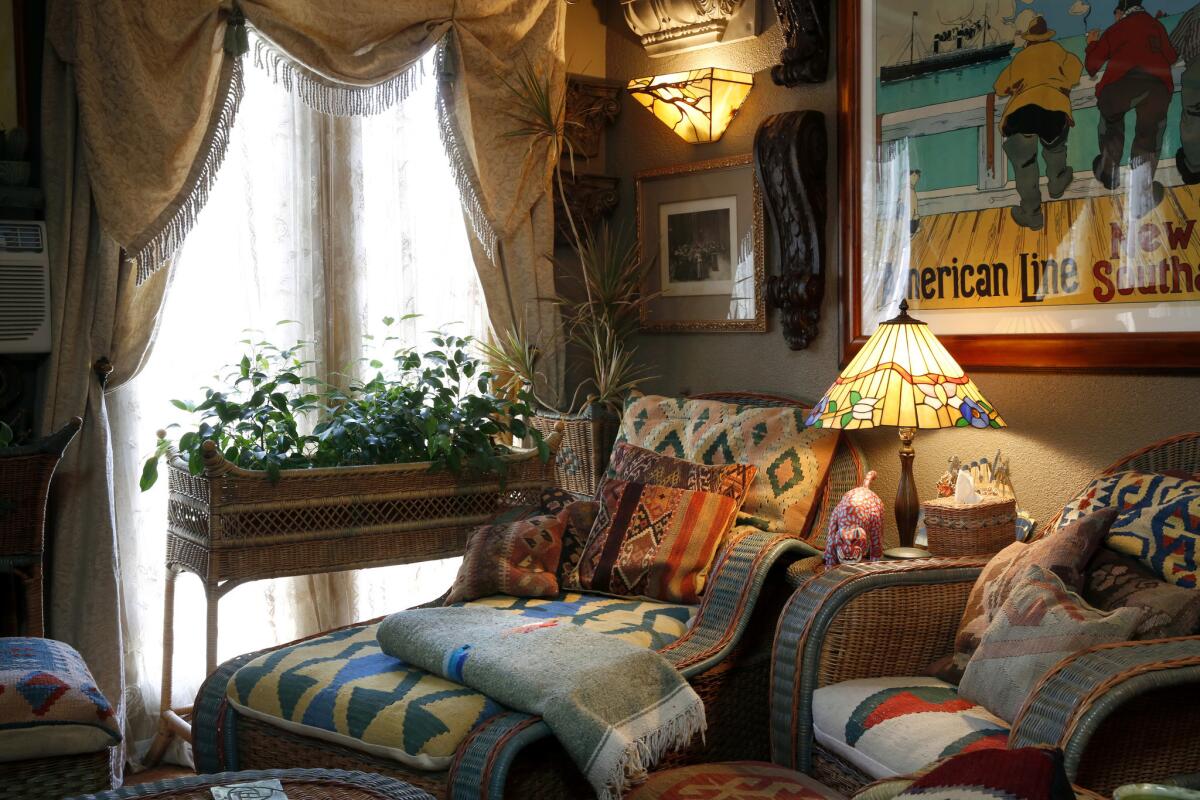
Between the guest room and his library, Iacovelli created a reading room. “This room was formerly the porch to the back unit and just last year I enclosed it,” he says. Mid-1980s wicker from Macy’s, the first furniture he bought in L.A., is enlivened with Southwestern textiles and kilim cushions.
Iacovelli takes inspiration from the English architect John Soane, whose collection of antiquities and architectural salvage is now a museum in London, and Hollywood designer Tony Duquette, who fashioned extravagant sculpture and furniture from common materials.
“Based on my work, people might think I am a minimalist,” says the designer, whose work will be seen in six Southern California play productions in the first half of 2016. “But in my home, I am exactly the opposite. I am a maximalist. It’s never really been in fashion. But the careful consideration of things in the theater has made me confident. I am not afraid of filling walls and shelves with stuff. A lot of it has personal significance — a painting from a boyfriend — and some of it is goofy stuff pulled out of a dumpster.”
For his work and his home, Iacovelli shops in thrift shops around the city and the world and scours EBay, the Rose Bowl and Long Beach flea markets, local textile dealers such as Michael Levine and Diamond Foam and Fabric, and Atwater Village businesses including Jill’s Paint and Mortarless Building Supply. He buys gold-leaf masks by Venetian artist Sergio Boldrin at Pergolina in Toluca Lake and has scored Tiffany lamps at a nearby Out of the Closet thrift shop.
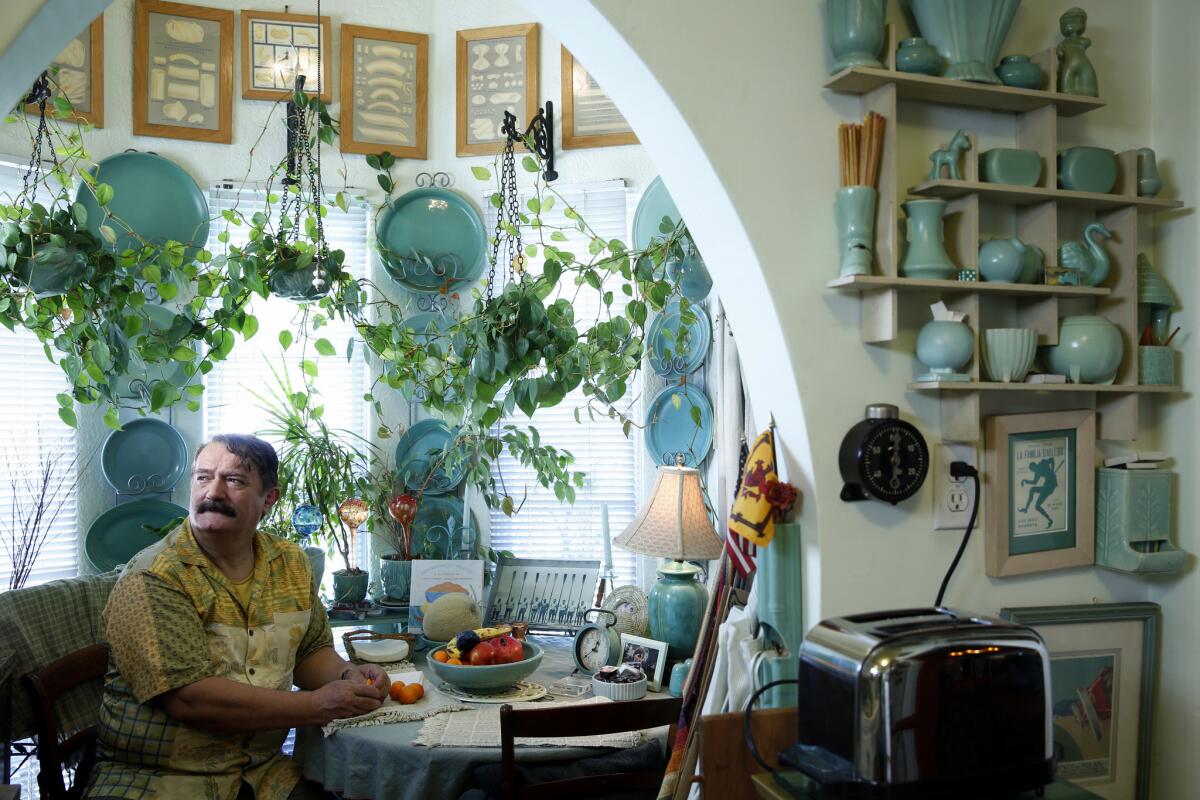
The breakfast nook walls, painted with Benjamin Moore Italian Ice Cream, are covered in framed pages from Italian pasta catalogs and classic California pottery serving platters. Iacovelli sits in an English Victorian side chair at a maple 1930s American kitchen table.
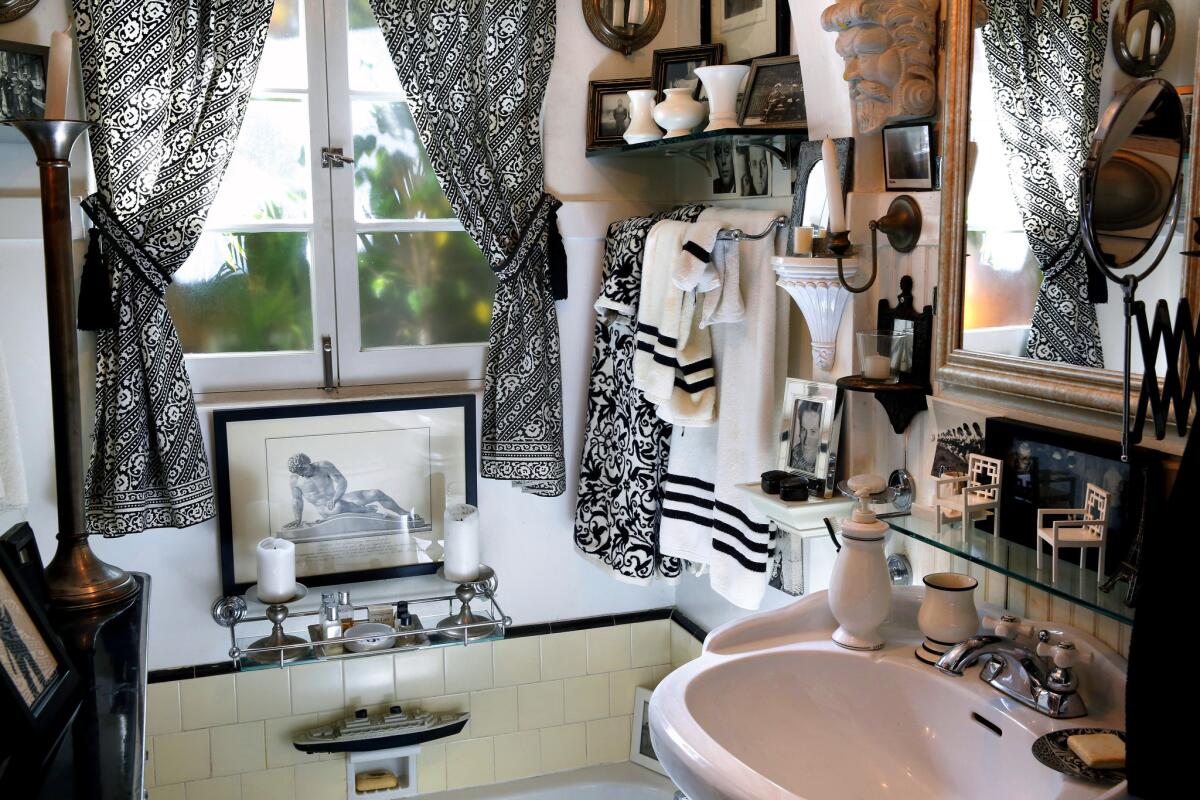
Not every element of the bathroom is vintage. The fabric used on the windows is a black and white print from Ikea and the sink is a contemporary Home Depot model with old-fashioned styling.
He used the latter to illuminate a former front porch for the back house that he recently enclosed and filled with wicker furniture, Southwestern textiles and kilim cushions. “I think of this room as the womb of my house,” says Iacovelli, who earned an MFA in scenic design and art direction at the Tisch School of the Arts at New York University. “It is cozy for reading and taking naps.”
By contrast, his green and white kitchen in the main house, which has the original 1920s hexagonal tile counters and linoleum flooring from the 1950s, is often a bustling space. “These days many kitchens look sterile and everything is hidden away in ‘appliance garages’ and the like,” Iacovelli says. “This really is a cook’s kitchen that gets used, and this plan — where everything is on view — suits me. I can make my father’s lasagna with two helpers and no one gets in the way.”
Iacovelli admits that his more-is-more decorating style may not be for everyone. “My house is hard on a person who is bigger. You really have to navigate it. And I would have asthma by now if I had to dust everything.”
Being a stage and screen designer has influenced how he decorates and personalizes his own spaces. “Every surface, every wall, every room is a composition and it tells a story,” Iacovelli says. “My home is a kind of mad scientist’s laboratory. I am always rearranging and fiddling and fixing. It is never done.”
ALSO:
Just 960 square feet: A 1925 bungalow gets remodeled for a growing family
A termite-ridden garage in Venice Beach is turned into a private video art gallery
Inside a Palm Springs getaway that’s modern, hip -- and still kid-friendly
